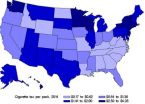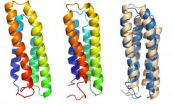(Press-News.org) CHICAGO --- After 50 years of being a mainstay cholesterol therapy, niacin should no longer be prescribed for most patients due to potential increased risk of death, dangerous side effects and no benefit in reducing heart attacks and strokes, writes Northwestern Medicine® preventive cardiologist Donald Lloyd-Jones, M.D., in a New England Journal of Medicine editorial.
Lloyd-Jones's editorial is based on a large new study published in the journal that looked at adults, ages 50 to 80, with cardiovascular disease who took extended-release niacin (vitamin B3) and laropiprant (a drug that reduces face flushing caused by high doses of niacin) to see if it reduced heart attack and stroke compared to a placebo over four years. All patients in the trial were already being treated with a statin medication.
Niacin did not reduce heart attacks and stroke rates compared with a placebo. More concerning, niacin was associated with an increased trend toward death from all causes as well as significant increases in serious side effects: liver problems, excess infections, excess bleeding, gout, loss of control of blood sugar for diabetics and the development of diabetes in people who didn't have it when the study began.
"There might be one excess death for every 200 people we put on niacin," said Lloyd-Jones,
chair of preventive medicine at Northwestern University Feinberg School of Medicine and Northwestern Memorial Hospital. "With that kind of signal, this is an unacceptable therapy for the vast majority of patients."
"For the reduction of heart disease and stroke risk, statins remain the most important drug-based strategy by far because of their demonstrated benefit and their good safety profile," said Lloyd-Jones, who was a member of the task force that rewrote cholesterol treatment guidelines in 2013 for the American College of Cardiology and the American Heart Association.
Niacin should be reserved only for patients at very high risk for a heart attack and stroke who can't take statins and for whom there are no other evidence-based options, Lloyd-Jones said.
Niacin raises "good" HDL (high density lipoprotein) cholesterol levels, and having high HDL levels means a lowered risk for cardiovascular events. But clinical trials have not shown that niacin reduced the risk of coronary heart disease or the broader cardiovascular disease specifically by raising HDL. Niacin also produces a modest reduction in low-density lipoprotein (LDL cholesterol) and a more substantial reduction in triglyceride levels, which might be expected to lower the risk of coronary heart disease, Lloyd-Jones notes in the article.
But the new study suggests that higher HDL levels only are a sign of lowered risk for heart attacks and stroke. Raising HDL levels with niacin does not appear to impact cardiovascular outcomes nor does lowering triglyceride levels, Lloyd-Jones points out.
"The recent niacin clinical trials offer important new evidence that raising 'good' cholesterol (HDL) levels on top of statin therapy does not have the positive outcome that had been hoped for," said Neil Stone, M.D., the Robert Bonow MD Professor in Cardiology at Feinberg and a cardiologist at Northwestern Memorial Hospital. "Lowering 'bad' cholesterol (LDL) with an optimal intensity of tolerated statins and adherence to healthy lifestyle changes remains the most effective approach to prevent strokes and heart attacks for patients at risk of cardiovascular disease."
INFORMATION:
Stone was chair of the expert panel that wrote rewrote cholesterol treatment guidelines in 2013 for the American College of Cardiology and the American Heart Association.
Highlights
Niacin does not reduce heart attacks or strokes
Niacin linked to increase in death risk, excess bleeding and diabetes
Statins remain best choice to reduce heart attack and stroke risk
NORTHWESTERN NEWS: http://www.northwestern.edu/newscenter/
Niacin too dangerous for routine cholesterol therapy
Mainstay drug now linked to death risk, dangerous side effects and no benefits
2014-07-17
ELSE PRESS RELEASES FROM THIS DATE:
NIH scientists identify gene linked to fatal inflammatory disease in children
2014-07-17
Investigators have identified a gene that underlies a very rare but devastating autoinflammatory condition in children. Several existing drugs have shown therapeutic potential in laboratory studies, and one is currently being studied in children with the disease, which the researchers named STING-associated vasculopathy with onset in infancy (SAVI). The findings appeared online today in the New England Journal of Medicine. The research was done at the National Institute of Arthritis and Musculoskeletal and Skin Diseases (NIAMS), part of the National Institutes of Health.
"Not ...
No-wait data centers
2014-07-17
Big websites usually maintain their own "data centers," banks of tens or even hundreds of thousands of servers, all passing data back and forth to field users' requests. Like any big, decentralized network, data centers are prone to congestion: Packets of data arriving at the same router at the same time are put in a queue, and if the queues get too long, packets can be delayed.
At the annual conference of the ACM Special Interest Group on Data Communication, in August, MIT researchers will present a new network-management system that, in experiments, reduced the average ...
Marginal life expectancy benefit from contralateral prophylactic mastectomy
2014-07-16
The choice of contralateral prophylactic mastectomy (CPM) by women with breast cancer (BC) diagnosed in one breast has recently increased in the US but may confer only a marginal life expectancy benefit depending on the type and stage of cancer, according to a study published July 16 in the JNCI: Journal of the National Cancer Institute.
To assess the survival benefit of CPM, Pamela R. Portschy, of the Department of Surgery, University of Minnesota, Minneapolis, and colleagues, developed a model simulating survival outcomes of CPM or no CPM for women with newly diagnosed ...
Screening costs increased in older women without changing detection rates of ESBC
2014-07-16
Medicare spending on breast cancer screening increased substantially between 2001 and 2009 but the detection rates of early stage tumors were unchanged, according to a new study published July 16 in the JNCI: Journal of the National Cancer Institute.
The effect of introduction of new breast cancer screening modalities, such as digital images, computer-aided detection (CAD), and use of ultrasound and MRI on screening costs among older women is unknown, although women over the age of 65 represent almost one-third of the total women screened in the US annually. There is ...
Even mild traumatic brain injury may cause brain damage
2014-07-16
MINNEAPOLIS – Even mild traumatic brain injury may cause brain damage and thinking and memory problems, according to a study published in the July 16, 2014, online issue of Neurology®, the medical journal of the American Academy of Neurology.
For the study, 44 people with a mild traumatic brain injury and nine people with a moderate traumatic brain injury were compared to 33 people with no brain injury. All of the participants took tests of their thinking and memory skills. At the same time, they had diffusion tensor imaging scans, a type of MRI scan that is more sensitive ...
RNs' delayed retirement boosts US nursing supplies, study finds
2014-07-16
Older registered nurses are working longer than in the past, one reason that the nation's supply of RNs has grown substantially in recent years, according to a new study.
Researchers found that from 1991 to 2012, among registered nurses working at age 50, 24 percent remained working as late as age 69. This compared to 9 percent during the period from 1969 to 1990. The findings are published online by the journal Health Affairs.
"We estimate this trend accounts for about a quarter of an unexpected surge in the supply of registered nurses that the nation has experienced ...
Persistent symptoms following concussion may be posttraumatic stress disorder
2014-07-16
Bottom Line: The long-lasting symptoms that many patients contend with following mild traumatic brain injury (MTBI), also known as concussion, may be posttraumatic disorder (PTSD) and not postconcussion syndrome (PCS).
Authors: Emmanuel Lagarde, Ph.D., of the Université de Bordeaux, France, and colleagues.
Background: Concussion accounts for more than 90 percent of all TBIs, although little is known about prognosis for the injury. The symptoms cited as potentially being part of PCS fall into three areas: cognitive, somatic and emotional. But the interpretation of symptoms ...
Study examines shift in resuscitation practices in military combat hospitals
2014-07-16
Bottom Line: Widespread military adoption of damage control resuscitation (DCR) policies has shifted resuscitation practices at combat hospitals during conflicts.
Author: Nicholas R. Langan, M.D., and colleagues from the Madigan Army Medical Center, Tacoma, Wash.
Background: Operation Iraqi Freedom (OIF) and Operation Enduring Freedom (OEF) are the first prolonged conflicts the United States has been involved in since the Vietnam War. Medical and surgical advances have often emerged from the battlefields. One of the most important advancements in combat trauma care ...
Study: Smoking may contribute to suicide risk
2014-07-16
AUDIO:
People who smoke cigarettes commit suicide at higher rates than those who don't smoke. That's been known for years, but most scientists assumed the reason was that smoking rates were...
Click here for more information.
Cigarette smokers are more likely to commit suicide than people who don't smoke, studies have shown. This reality has been attributed to the fact that people with psychiatric disorders, who have higher suicide rates, also tend to smoke. But new research ...
Cell membrane proteins give up their secrets
2014-07-16
HOUSTON – (July 16, 2014) – Rice University scientists have succeeded in analyzing transmembrane protein folding in the same way they study the proteins' free-floating, globular cousins.
Rice theoretical biologist Peter Wolynes and his team at the university's Center for Theoretical Biological Physics (CTBP) have applied his energy landscape theory to proteins that are hard to view because they live and work primarily inside cell membranes.
The method should increase the technique's value to researchers who study proteins implicated in diseases and possibly in the ...
LAST 30 PRESS RELEASES:
Global psychiatry mourns Professor Dan Stein, visionary who transformed mental health science across Africa and beyond
KIST develops eco-friendly palladium recovery technology to safeguard resource security
Statins significantly reduce mortality risk for adults with diabetes, regardless of cardiovascular risk
Brain immune cells may drive more damage in females than males with Alzheimer’s
Evidence-based recommendations empower clinicians to manage epilepsy in pregnancy
Fungus turns bark beetles’ defenses against them
There are new antivirals being tested for herpesviruses. Scientists now know how they work
CDI scientist, colleagues author review of global burden of fungus Candida auris
How does stroke influence speech comprehension?
B cells transiently unlock their plasticity, risking lymphoma development
Advanced AI dodel predicts spoken language outcomes in deaf children after cochlear implants
Multimodal imaging-based cerebral blood flow prediction model development in simulated microgravity
Accelerated streaming subgraph matching framework is faster, more robust, and scalable
Gestational diabetes rose every year in the US since 2016
OHSU researchers find breast cancer drug boosts leukemia treatment
Fear and medical misinformation regarding risk of progression or recurrence among patients with breast cancer
Glucagonlike peptide-1 receptor agonists and asthma risk in adolescents with obesity
Reviving dormant immunity: Millimeter waves reprogram the immunosuppressive microenvironment to potentiate immunotherapy without obvious side effects
Safety decision-making for autonomous vehicles integrating passenger physiological states by fNIRS
Fires could emit more air pollution than previously estimated
A new way to map how cells choose their fate
Numbers in our sights affect how we perceive space
SIMJ announces global collaborative book project in commemoration of its 75th anniversary
Air pollution exposure and birth weight
Obstructive sleep apnea risk and mental health conditions among older adults
How talking slows eye movements behind the wheel
The Ceramic Society of Japan’s Oxoate Ceramics Research Association launches new international book project
Heart-brain connection: international study reveals the role of the vagus nerve in keeping the heart young
Researchers identify Rb1 as a predictive biomarker for a new therapeutic strategy in some breast cancers
Survey reveals ethical gaps slowing AI adoption in pediatric surgery
[Press-News.org] Niacin too dangerous for routine cholesterol therapyMainstay drug now linked to death risk, dangerous side effects and no benefits

